So I'm trying to achieve the "Polygon Art/Low Poly" style with LibGDX. I start by constructing a model made of triangles.

Then with the vertex shader, I calculate the colors for each vertex based on height.

Problem is, the terrain is Gouraud shaded when I want it to be flat shaded like this:

I know that with higher versions of OpenGL there's a "flat" keyword in glsl that will disable the interpolation of colors between vertices. From what I read online and in this post: https://i.stack.imgur.com/DrNx9.jpg , I think that I would need to have each triangle in the terrain be separate from each other? I would also need to calculate the normal per triangle? I couldn't understand the code in the other StackOverflow, but this is what I tried to do:
Original
public Model getWorld(){
returnWorld = new Model();
modelBuilder = new ModelBuilder();
modelBuilder.begin();
worldMeshBuilder = modelBuilder.part("worldPart", GL20.GL_TRIANGLES, Usage.Position | Usage.Normal, new Material());
pieceMeshBuilder = new MeshBuilder();
meshPiece = new Mesh(false, 3, 3,
new VertexAttribute(Usage.Position, 3, "a_position"),
new VertexAttribute(Usage.Normal, 3, "a_normal"),
new VertexAttribute(Usage.ColorPacked, 4, "a_color"));
Vector3 vectorCopy = new Vector3();
for(int i = 0; i < world.length - 1; i++){
for(int j = 0; j < world[0].length - 1; j++){
if((i + j) % 2 == 0){
pieceMeshBuilder.begin(Usage.Position | Usage.Normal, renderType);
pieceMeshBuilder.triangle(
vectorCopy = verticies[i][j],
vectorCopy = verticies[i][j + 1],
vectorCopy = verticies[i + 1][j + 1]
);
worldMeshBuilder.addMesh(pieceMeshBuilder.end());
pieceMeshBuilder.begin(Usage.Position | Usage.Normal, renderType);
pieceMeshBuilder.triangle(
vectorCopy = verticies[i + 1][j + 1],
vectorCopy = verticies[i + 1][j],
vectorCopy = verticies[i][j]
);
worldMeshBuilder.addMesh(pieceMeshBuilder.end());
} else {
pieceMeshBuilder.begin(Usage.Position | Usage.Normal, renderType);
pieceMeshBuilder.triangle(
vectorCopy = verticies[i][j],
vectorCopy = verticies[i][j + 1],
vectorCopy = verticies[i + 1][j]
);
worldMeshBuilder.addMesh(pieceMeshBuilder.end());
pieceMeshBuilder.begin(Usage.Position | Usage.Normal, renderType);
pieceMeshBuilder.triangle(
vectorCopy = verticies[i + 1][j + 1],
vectorCopy = verticies[i + 1][j],
vectorCopy = verticies[i][j + 1]
);
worldMeshBuilder.addMesh(pieceMeshBuilder.end());
}
}
}
returnWorld = modelBuilder.end();
return returnWorld;
}
Now:
public Model getWorld(){
returnWorld = new Model();
modelBuilder = new ModelBuilder();
modelBuilder.begin();
worldMeshBuilder = modelBuilder.part("worldPart", GL20.GL_LINES, Usage.Position | Usage.Normal, new Material());
for(int i = 0; i < world.length - 1; i++){
for(int j = 0; j < world[0].length - 1; j++){
Vector3 normal1 = calcNormal(verticies[i][j], verticies[i + 1][j], verticies[i + 1][j + 1]);
Vector3 normal2 = calcNormal(verticies[i][j], verticies[i + 1][j + 1], verticies[i][j + 1]);
if((i + j) % 2 == 0){
meshPiece = new Mesh(false, 18, 3,
new VertexAttribute(Usage.Position, 3, "a_position"),
new VertexAttribute(Usage.Normal, 3, "a_normal")//,
//new VertexAttribute(Usage.ColorPacked, 4, "a_color")
);
worldMeshBuilder.addMesh(meshPiece.setVertices(new float[] {
verticies[i][j].x, verticies[i][j].y, verticies[i][j].z, normal1.x, normal1.y, normal1.z,
verticies[i + 1][j].x, verticies[i + 1][j].y, verticies[i + 1][j].z, normal1.x, normal1.y, normal1.z,
verticies[i + 1][j + 1].x, verticies[i + 1][j + 1].y, verticies[i + 1][j + 1].z, normal1.x, normal1.y, normal1.z,
}));
meshPiece = new Mesh(false, 18, 3,
new VertexAttribute(Usage.Position, 3, "a_position"),
new VertexAttribute(Usage.Normal, 3, "a_normal")//,
//new VertexAttribute(Usage.ColorPacked, 4, "a_color")
);
worldMeshBuilder.addMesh(meshPiece.setVertices(new float[] {
verticies[i][j].x, verticies[i][j].y, verticies[i][j].z, normal2.x, normal2.y, normal2.z,
verticies[i + 1][j + 1].x, verticies[i + 1][j + 1].y, verticies[i + 1][j + 1].z, normal2.x, normal2.y, normal2.z,
verticies[i][j + 1].x, verticies[i][j + 1].y, verticies[i][j + 1].z, normal2.x, normal2.y, normal2.z,
}));
} else {
meshPiece = new Mesh(false, 18, 3,
new VertexAttribute(Usage.Position, 3, "a_position"),
new VertexAttribute(Usage.Normal, 3, "a_normal")//,
//new VertexAttribute(Usage.ColorPacked, 4, "a_color")
);
worldMeshBuilder.addMesh(meshPiece.setVertices(new float[] {
verticies[i][j].x, verticies[i][j].y, verticies[i][j].z, normal1.x, normal1.y, normal1.z,
verticies[i + 1][j].x, verticies[i + 1][j].y, verticies[i + 1][j].z, normal1.x, normal1.y, normal1.z,
verticies[i][j + 1].x, verticies[i][j + 1].y, verticies[i][j + 1].z, normal1.x, normal1.y, normal1.z,
}));
meshPiece = new Mesh(false, 18, 3,
new VertexAttribute(Usage.Position, 3, "a_position"),
new VertexAttribute(Usage.Normal, 3, "a_normal")//,
//new VertexAttribute(Usage.ColorPacked, 4, "a_color")
);
worldMeshBuilder.addMesh(meshPiece.setVertices(new float[] {
verticies[i + 1][j].x, verticies[i + 1][j].y, verticies[i + 1][j].z, normal2.x, normal2.y, normal2.z,
verticies[i + 1][j + 1].x, verticies[i + 1][j + 1].y, verticies[i + 1][j + 1].z, normal2.x, normal2.y, normal2.z,
verticies[i][j + 1].x, verticies[i][j + 1].y, verticies[i][j + 1].z, normal2.x, normal2.y, normal2.z,
}));
}
}
}
returnWorld = modelBuilder.end();
return returnWorld;
}
Problem is the new code isn't rendering anything... I have looked at the API for ModelBuilder, MeshBuilder, Mesh, and VertexAttribute/s but I can't figure out why it isn't working. Any help would be great as this has been a very frustrating day. Thank so much!
